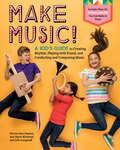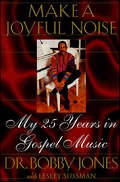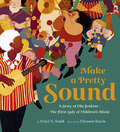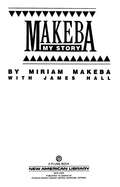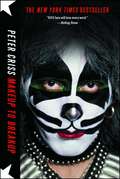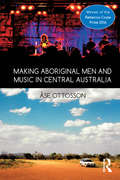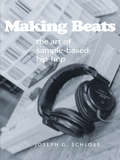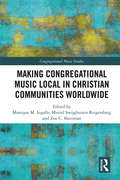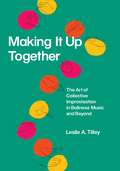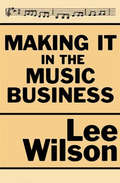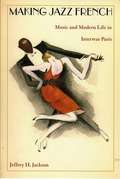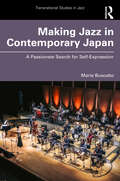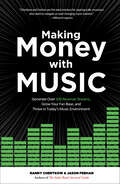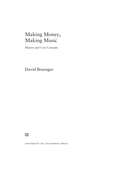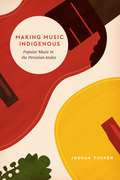- Table View
- List View
Make Job Loss Work for You
by Terri Deems Richard DeemsReaders learn to tackle their emotional reactions to job loss--including shock, anger, denial, self-doubt, and depression--and come to an acceptance that enables them to move forward with their careers. Then, using the proven Deems JobGetting Skills System, readers can pinpoint their ideal career direction and make all the right moves toward landing a new job, including resume and cover letter tips, search strategy, offer negotiation, and success in the new position.
Make Music!: A Kid's Guide to Creating Rhythm, Playing with Sound, and Conducting and Composing Music (Music Makes A Difference Ser.)
by John Langstaff Ann Sayre Wiseman Norma Jean HaynesMusic is for everyone — no prior experience required! Make Music! invites kids and families to celebrate the joy of sound with a variety of inventive activities, including playing dandelion trumpets, conducting percussion conversations, and composing their own pieces. Musician and educator Norma Jean Haynes brings the pioneering work of Ann Sayre Wiseman and John Langstaff to a new generation of kids aged 5 and up, focusing on the playfulness, spontaneity, and creativity of music. Kids explore rhythm with clapping, body drumming, and intonations. They learn to create found sound with kitchen pots and pans, the Sunday paper, or even the Velcro on their sneakers. And step-by-step instructions show how to make 35 different instruments, from chimes and bucket drums to a comb kazoo and a milk carton guitar. This publication conforms to the EPUB Accessibility specification at WCAG 2.0 Level AA.
Make Some Noise: The mind-blowing guide to all things music by the world’s funniest band
by The Horne Section*The funniest band in the world, The Horne Section (fronted by Taskmaster's Alex Horne), tell you everything you need to know to be a music genius - with bizarre tales, absurd history and unbelievable facts.*'An explosion of silliness . . the whole family will get something from it' Guardian on The Horne Section TV showWith FUNNY tales, ABSURD history and UNBELIEVABLE facts, this mind-blowing guide to music can help anyone become a sound-making sensation.In this book, you'll find answers to those all-important questions, such as:- Why is cabbage the key to musical genius?- Which is the fartiest of all the instruments?- Which song has the FUNNIEST lyrics of all time?Band leader Alex Horne has also added some special tasks throughout the book, so readers will be making their own music in no time at all - without even leaving the house!
Make Your Own Electric Guitar
by David LacasaThe first choice of aspiring guitar makers for more than 30 years For some, it is not enough to buy a guitar—the challenge of designing and hand-making a unique, customized instrument is the dream. Since 1986, these people have turned to one book: Make Your Own Electric Guitar. Written in a clear, relaxed style, it covers every facet of guitar design and construction, as well as electronic theory and practice, and full woodworking and wiring techniques—all supported with plenty of photos and diagrams. Now in a revised and expanded third edition, Make Your Own Electric Guitar will enable any musician or enthusiast with basic woodworking skills to create a uniquely valuable instrument.
Make Your Own Rules: Stories and Hard-Earned Advice from a Creator in the Digital Age
by Andrew HuangYouTube sensation Andrew Huang offers practical tips and hard-won advice for creatives seeking financial stability while staying authentic.How does a musician with acute hearing loss, a refusal to perform live, and no industry connections carve a path to millions of followers and lucrative royalty checks? In Make Your Own Rules, Andrew Huang shares stories from his two decades as a music industry misfit and offers advice on both the artistic and business sides of working as a creator in our digital era. Beginning with auctioning his songwriting skills on eBay as a teenager, Andrew continuously found new ways to thrive in a music career over the last twenty-plus years. His storied career and hard-won wisdom can help aspiring digital creatives find success as well. Organized by sections on building your creative foundations, growing an audience in the digital age, making money, and staying true to yourself, Make Your Own Rules pairs personal anecdotes with concrete advice applicable to any freelance digital creator. You&’ll learn how Andrew became an early adopter of sharing music online—for free!—and how he leveraged social media to grow an organic following and amass millions of song streams and video views. Additional chapters provide insight into his designing an online course and music production tools that have been used by tens of thousands of people, and how he created revenue streams for himself that didn&’t exist previously. With open-minded perseverance, Andrew made up his own rules for life. His unlikely journey will inspire creators to find opportunity, financial stability, and fun in their pursuits.
Make a Joyful Noise: My 25 Years in Gospel Music
by Bobby Jones Lesley SussmanDr. Bobby Jones, a leading figure in the gospel music industry, offers a revealing look at his career and friendships with other celebrities.Jones is the host and executive producer of the world's number one gospel television program with a viewership exceeding five million. He shares with readers his own personal journey from an impoverished childhood where his love of education and Christian music played a major role in his becoming a prominent award-winning leader in the gospel music world. Jones counts many of gospel's most beloved celebrities as his friends, including Aretha Franklin, Shirley Caesar, Kirk Franklin, the Winans, and Barbara Mandrell. His book provides intimate and inspirational details of these friendships.
Make a Pretty Sound: A Story of Ella Jenkins—The First Lady of Children's Music
by Traci N. ToddOnce upon a time, children's music was just Mother Goose, nursery songs, and lullabies. And then came Ella Jenkins.Ella Jenkins is an American folk singer and living legend dubbed "The First Lady of Children’s Music." For nearly 70 years, she has been writing and performing music that has entertained and engaged generations of young listeners. In Make a Pretty Sound, Ella’s life and legacy are captured in vibrant sights, sounds, and stories that leap right off the page. Born in St. Louis, Missouri, and raised in Chicago, Ella grew up loving music of all kinds—the call-and-response of Cab Calloway, the exciting rhythms of Moroccan and Indian records spun in a local record shop, the bluesy notes her uncle teased from his harmonica. She listened to music from around the world, and no matter what language it was in, she could feel what it meant—the bridge in understanding and feeling that music offers from one heart to another. When she began working with children, she knew just what to do. She knew music would offer children a kinetic learning experience that engaged them physically, verbally, and empathetically, creating community out of song. Soon, she was recording her own albums and became an international star. In these beautifully illustrated pages, Ella’s journey—from the gritty streets of Chicago to the classrooms where she found her calling to an opportunity to raise her voice for freedom alongside Martin Luther King, Jr., to the spotlight of the world’s stage—is rhythmically, joyfully, brilliantly illuminated. For readers familiar with Ella Jenkins or new to her work, this nonfiction picture book offers a treasury of inspiration that touches on American history, civil rights, cultural awareness, and the incredible power of music.A LIVING LEGEND: Drawing on personal interviews the author conducted with Ella and her manager, this is Ella’s story told in her own words. For all who have felt the impact of her work in children's programming, in classrooms, and in their homes, this is a wonderful opportunity to explore the legacy of an artist who offers children the gift of music and the gift of knowing that another human heart reaches out to theirs. LYRICAL TEXT AND ART: Rhythmic text and colorful illustrations celebrate the musicality of Ella's life and convey the singular joy that is found in the sharing of music! BEAUTIFUL GIFT BOOK: With extraordinary writing and beautiful art, this book makes a perfect present for any young reader who loves music, biographies, or both.Perfect for: Fans of Ella Jenkins Parents, teachers, and caregivers of children who love music Teachers and librarians looking for a great picture book biography Anyone interested in multicultural music for kids Readers who enjoy the Little People, BIG DREAMS and Who Is/Who Was biography series Gift givers looking for a children’s music book for birthday, holiday, or any celebratory occasion
Makeba: My Story
by James A. HallThe renowned South African singer and political activist recounts her life--a life that encompasses the splendor of international acclaim, bitter personal tragedy, and political intrigue and violence
Makeup to Breakup: My Life In and Out of Kiss
by Peter CrissLEGENDARY founding KISS drummer Peter “Catman” Criss has lived an incredible life in music, from the streets of Brooklyn to the social clubs of New York City to the ultimate heights of rock ’n’ roll success and excess. KISS formed in 1973 and broke new ground with their elaborate makeup, live theatrics, and powerful sound. The band emerged as one of the most iconic hard rock acts in music history. Peter Criss, the Catman, was the heartbeat of the group. From an elevated perch on his pyrotechnic drum riser, he had a unique vantage point on the greatest rock show of all time, with the KISS Army looking back at him night after night. Peter Criscuola had come a long way from the homemade drum set he pounded on nonstop as a kid growing up in Brooklyn in the fifties. He endured lean years, street violence, and the rollercoaster music scene of the sixties, but he always knew he’d make it. Makeup to Breakup is Peter Criss’s eye-opening journey from the pledge to his ma that he’d one day play Madison Square Garden to doing just that. He conquered the rock world—composing and singing his band’s all-time biggest hit, “Beth” (1976)—but he also faced the perils of stardom and his own mortality, including drug abuse, treatment in 1982, near-suicides, two broken marriages, and a hard-won battle with breast cancer. Criss opens up with a level of honesty and emotion previously unseen in any musician’s memoir. Makeup to Breakup is the definitive and heartfelt account of one of rock’s most iconic figures, and the importance of faith and family. Rock ’n’ roll has been chronicled many times, but never quite like this.
Making Aboriginal Men and Music in Central Australia (Criminal Practice Ser.)
by Ase OttossonThis detailed ethnographic study explores the intercultural crafting of contemporary forms of Aboriginal manhood in the world of country, rock and reggae music making in Central Australia. Focusing on four different musical contexts – an Aboriginal recording studio, remote Aboriginal settlements, small non-indigenous towns, and tours beyond the musicians’ homeland – the author challenges existing scholarly, political and popular understandings of Australian Aboriginal music, men, and related indigenous matters in terms of radical social, cultural and racial difference. Based on extensive anthropological field research among Aboriginal rock, country and reggae musicians in small towns and remote desert settlements in Central Australia, the book investigates how Aboriginal musicians experience and articulate various aspects of their male and indigenous sense of selves as they make music and engage with indigenous and non-indigenous people, practices, places, and sets of values.Making Aboriginal Men and Music is a highly original, intimate study which advances our understanding of contemporary indigenous and male identity formation within Aboriginal Australian society. Providing new analytical insights for scholars and students in fields such as social and cultural anthropology, cultural studies, popular music, and gender studies, this engaging text makes a significant contribution to the study of indigenous identity formation in remote Australia and beyond.
Making Beats
by Joseph G. SchlossDespite having created one of the most important musical cultures of the last fifty years, hip-hop composers who use digital sampling are rarely taken seriously as artists. But hip-hop deejays and producers have collectively developed an artistic system that features a complex aesthetic, a detailed array of social protocols, a rigorous set of ethical expectations and a rich historical consciousness. Based on ten years of research among hip-hop producers, Making Beats is the first work of scholarship to explore the goals, methods and values of this surprisingly insular community. Focusing on a variety of subjects--from hip-hop artists' pedagogical methods to the Afro-diasporic roots of the sampling process to the social significance of "digging" for rare records--Joseph G. Schloss examines the way hip-hop artists have managed to create a form of expression that reflects their creative aspirations, moral beliefs, political values and cultural realities.
Making Beats: The Art of Sample-Based Hip-Hop (Music Culture)
by Joseph G. SchlossWinner of IASPM's 2005 International Book AwardBased on ten years of research among hip-hop producers, Making Beats was the first work of scholarship to explore the goals, methods, and values of a surprisingly insular community. Focusing on a variety of subjects—from hip-hop artists' pedagogical methods to the Afrodiasporic roots of the sampling process to the social significance of "digging" for rare records—Joseph G. Schloss examines the way hip-hop artists have managed to create a form of expression that reflects their creative aspirations, moral beliefs, political values, and cultural realities. This second edition of the book includes a new foreword by Jeff Chang and a new afterword by the author.
Making Congregational Music Local in Christian Communities Worldwide (Congregational Music Studies Series)
by Zoe C. Sherinian Monique M. Ingalls Muriel Swijghuisen ReigersbergWhat does it mean for music to be considered local in contemporary Christian communities, and who shapes this meaning? Through what musical processes have religious beliefs and practices once ‘foreign’ become ‘indigenous’? How does using indigenous musical practices aid in the growth of local Christian religious practices and beliefs? How are musical constructions of the local intertwined with regional, national or transnational religious influences and cosmopolitanisms? Making Congregational Music Local in Christian Communities Worldwide explores the ways that congregational music-making is integral to how communities around the world understand what it means to be ‘local’ and ‘Christian’. Showing how locality is produced, negotiated, and performed through music-making, this book draws on case studies from every continent that integrate insights from anthropology, ethnomusicology, cultural geography, mission studies, and practical theology. Four sections explore a central aspect of the production of locality through congregational music-making, addressing the role of historical trends, cultural and political power, diverging values, and translocal influences in defining what it means to be ‘local’ and ‘Christian’. This book contends that examining musical processes of localization can lead scholars to new understandings of the meaning and power of Christian belief and practice.
Making It Happen: How to Create a Sustainable Career in the Music Industry
by Hannah TrigwellMaking It Happen is a comprehensive guide to navigating the modern music industry, that redefines what ‘making it’ means for musicians, and inspires and educates musicians on the different options for generating revenue from their art. This book offers theoretical and practical advice on making music, creating promotional content and embracing traditional and emerging social media platforms into your marketing strategies. Through interviews with music industry experts, readers can expect professional tips and advice, as well as clear instructions on how to build a dream team, make content, share that work and grow an audience to enable long-term business sustainability. In the modern music industry, having multiple revenue streams leads to a stable income. Making It Happen offers unique insights into the innovations and technologies available to contemporary music makers, making it essential reading for independent musicians, music business students, music producers and marketers.
Making It Up Together: The Art of Collective Improvisation in Balinese Music and Beyond (Chicago Studies in Ethnomusicology)
by Leslie A. TilleyMost studies of musical improvisation focus on individual musicians. But that is not the whole story. From jazz to flamenco, Shona mbira to Javanese gamelan, improvised practices thrive on group creativity, relying on the close interaction of multiple simultaneously improvising performers. In Making It Up Together, Leslie A. Tilley explores the practice of collective musical improvisation cross-culturally, making a case for placing collectivity at the center of improvisation discourse and advocating ethnographically informed music analysis as a powerful tool for investigating improvisational processes. Through two contrasting Balinese case studies—of the reyong gong chime’s melodic norot practice and the interlocking drumming tradition kendang arja—Tilley proposes and tests analytical frameworks for examining collectively improvised performance. At the micro-level, Tilley’s analyses offer insight into the note-by-note decisions of improvising performers; at the macro-level, they illuminate larger musical, discursive, structural, and cultural factors shaping those decisions. This multi-tiered inquiry reveals that unpacking how performers play and imagine as a collective is crucial to understanding improvisation and demonstrates how music analysis can elucidate these complex musical and interactional relationships. Highlighting connections with diverse genres from various music cultures, Tilley’s examinations of collective improvisation also suggest rich potential for cross-genre exploration. The surrounding discussions point to larger theories of communication and interaction, creativity and cognition that will be of interest to a range of readers—from ethnomusicologists and music theorists to cognitive psychologists, jazz studies scholars, and improvising performers. Setting new parameters for the study of improvisation, Making It Up Together opens up fresh possibilities for understanding the creative process, in music and beyond.
Making It Up Together: The Art of Collective Improvisation in Balinese Music and Beyond (Chicago Studies in Ethnomusicology)
by Leslie A. TilleyMost studies of musical improvisation focus on individual musicians. But that is not the whole story. From jazz to flamenco, Shona mbira to Javanese gamelan, improvised practices thrive on group creativity, relying on the close interaction of multiple simultaneously improvising performers. In Making It Up Together, Leslie A. Tilley explores the practice of collective musical improvisation cross-culturally, making a case for placing collectivity at the center of improvisation discourse and advocating ethnographically informed music analysis as a powerful tool for investigating improvisational processes. Through two contrasting Balinese case studies—of the reyong gong chime’s melodic norot practice and the interlocking drumming tradition kendang arja—Tilley proposes and tests analytical frameworks for examining collectively improvised performance. At the micro-level, Tilley’s analyses offer insight into the note-by-note decisions of improvising performers; at the macro-level, they illuminate larger musical, discursive, structural, and cultural factors shaping those decisions. This multi-tiered inquiry reveals that unpacking how performers play and imagine as a collective is crucial to understanding improvisation and demonstrates how music analysis can elucidate these complex musical and interactional relationships. Highlighting connections with diverse genres from various music cultures, Tilley’s examinations of collective improvisation also suggest rich potential for cross-genre exploration. The surrounding discussions point to larger theories of communication and interaction, creativity and cognition that will be of interest to a range of readers—from ethnomusicologists and music theorists to cognitive psychologists, jazz studies scholars, and improvising performers. Setting new parameters for the study of improvisation, Making It Up Together opens up fresh possibilities for understanding the creative process, in music and beyond.
Making It Up Together: The Art of Collective Improvisation in Balinese Music and Beyond (Chicago Studies in Ethnomusicology)
by Leslie A. TilleyMost studies of musical improvisation focus on individual musicians. But that is not the whole story. From jazz to flamenco, Shona mbira to Javanese gamelan, improvised practices thrive on group creativity, relying on the close interaction of multiple simultaneously improvising performers. In Making It Up Together, Leslie A. Tilley explores the practice of collective musical improvisation cross-culturally, making a case for placing collectivity at the center of improvisation discourse and advocating ethnographically informed music analysis as a powerful tool for investigating improvisational processes. Through two contrasting Balinese case studies—of the reyong gong chime’s melodic norot practice and the interlocking drumming tradition kendang arja—Tilley proposes and tests analytical frameworks for examining collectively improvised performance. At the micro-level, Tilley’s analyses offer insight into the note-by-note decisions of improvising performers; at the macro-level, they illuminate larger musical, discursive, structural, and cultural factors shaping those decisions. This multi-tiered inquiry reveals that unpacking how performers play and imagine as a collective is crucial to understanding improvisation and demonstrates how music analysis can elucidate these complex musical and interactional relationships. Highlighting connections with diverse genres from various music cultures, Tilley’s examinations of collective improvisation also suggest rich potential for cross-genre exploration. The surrounding discussions point to larger theories of communication and interaction, creativity and cognition that will be of interest to a range of readers—from ethnomusicologists and music theorists to cognitive psychologists, jazz studies scholars, and improvising performers. Setting new parameters for the study of improvisation, Making It Up Together opens up fresh possibilities for understanding the creative process, in music and beyond.
Making It in the Music Business: The Business and Legal Guide for Songwriters and Performers
by Lee WilsonFrom an experienced entertainment lawyer, &“a terrific handbook that outlines all the information a fledgling musician or songwriter needs to know&” (Booklist). Early in their careers, most musicians find it hard to believe that their band might ever make enough money to fight over. But sooner than you think, success may arrive, and without clear terms that spell out how the band is organized and who controls what rights, your best friends and fellow musicians may become your worst enemies. Anyone who seeks to enter the complex world of the music business ought to know what to do in order to avoid derailing a high-speed ride to the top of the charts. This guide from a longtime intellectual property lawyer can help you get there—without breaking up the band.
Making Jazz French: Music and Modern Life in Interwar Paris
by Jeffrey H. JacksonBetween the world wars, Paris welcomed not only a number of glamorous American expatriates, including Josephine Baker and F. Scott Fitzgerald, but also a dynamic musical style emerging in the United States: jazz. Roaring through cabarets, music halls, and dance clubs, the upbeat, syncopated rhythms of jazz soon added to the allure of Paris as a center of international nightlife and cutting-edge modern culture. In Making Jazz French, Jeffrey H. Jackson examines not only how and why jazz became so widely performed in Paris during the 1920s and 1930s but also why it was so controversial. Drawing on memoirs, press accounts, and cultural criticism, Jackson uses the history of jazz in Paris to illuminate the challenges confounding French national identity during the interwar years. As he explains, many French people initially regarded jazz as alien because of its associations with America and Africa. Some reveled in its explosive energy and the exoticism of its racial connotations, while others saw it as a dangerous reversal of France's most cherished notions of "civilization. " At the same time, many French musicians, though not threatened by jazz as a musical style, feared their jobs would vanish with the arrival of American performers. By the 1930s, however, a core group of French fans, critics, and musicians had incorporated jazz into the French entertainment tradition. Today it is an integral part of Parisian musical performance. In showing how jazz became French, Jackson reveals some of the ways a musical form created in the United States became an international phenomenon and acquired new meanings unique to the places where it was heard and performed.
Making Jazz in Contemporary Japan: A Passionate Search for Self-Expression (ISSN)
by Marie BuscattoMaking Jazz in Contemporary Japan: A Passionate Search for Self-Expression explores the ways in which Japanese jazz musicians express themselves through their art—not to “japanize” jazz, but to assert one’s creativity, passion, and capacity for self-expression—establishing it as an art form with its own sense of musicality and cultural, social, and economic concerns. This ethnographic survey contextualizes a shift in the Japanese jazz world over the last 30 years: What once was a culture dependent on the American influence is now a thriving local scene creating a wide variety of original, transnational compositions. Based on digital and physical observations and extensive interviews with nearly three dozen Japanese professional jazz musicians while featuring portraits of well-known artists, this empirical investigation into how, where, and why jazz is performed, opens doors to touch on culturally sensitive and taboo topics such as gender, sexuality, and indigenization. Suited for readers in global jazz studies and cultural study programs alike, this book is a timely sociological consideration of the Japanese jazz diaspora, a necessary update to break free of established tropes and clichés envisioning Japanese artists as mere imitators.
Making Light: Haydn, Musical Camp, and the Long Shadow of German Idealism
by Raymond KnappIn Making Light Raymond Knapp traces the musical legacy of German Idealism as it led to the declining prestige of composers such as Haydn while influencing the development of American popular music in the nineteenth century. Knapp identifies in Haydn and in early popular American musical cultures such as minstrelsy and operetta a strain of high camp—a mode of engagement that relishes both the superficial and serious aspects of an aesthetic experience—that runs antithetical to German Idealism's musical paradigms. By considering the disservice done to Haydn by German Idealism alongside the emergence of musical camp in American popular music, Knapp outlines a common ground: a humanistically based aesthetic of shared pleasure that points to ways in which camp receptive modes might rejuvenate the original appeal of Haydn's music that has mostly eluded audiences. In so doing, Knapp remaps the historiographical modes and systems of critical evaluation that dominate musicology while troubling the divide between serious and popular music.
Making Money with Music: Generate Over 100 Revenue Streams, Grow Your Fan Base, and Thrive in Today's Music Environment
by Jason Feehan Randy Chertkow“[Chertkow and Feehan] are the ideal mentors for aspiring indie musicians who want to navigate an ever-changing music industry.” —Billboard MagazineYou can make a living with music today. The secret is to tap multiple income streams.Making Money With Music gives you over 100 revenue streams and the knowledge on how to tap them. Whether you're a solo artist, band, DJ, EDM producer, or other musician, this book gives you strategies to generate revenue, grow your fan base, and thrive in today's technology-driven music environment. Plus, it lists hundreds of services, tools, and critical resources you need to run your business and maximize income.Making Money With Music will show you:How to tap over 100 income streams7 business strategies you can implement immediately How to start your music business for $0. How to register your music to collect all of the royalties you are owed worldwide. 13 ways to compete with free and build experiences to drive fan loyalty and engagement into everything you do to increase your revenue. 45 categories of places to get your music heard and videos seen so you can get discovered, grow your fanbase, generate royalties, and boost licensing opportunities. 10 methods for raising money so you can fund your music production and projects. ...and more.Written by the authors of the critically-acclaimed modern classic The Indie Band Survival Guide (1st & 2nd Editions), Making Money With Music is the third installment in The Indie Band Survival Guide series, and will help you build a sustainable music business no matter what kind of music you make, where you live, and whether you're a novice or professional musician. Improve your income by implementing these ideas for your music business today.
Making Money, Making Music: History and Core Concepts
by David BruengerMaking Money, Making Music offers tools to encourage creative and adaptive entrepreneurship in the music business. Written for the classroom and the workplace, it introduces readers to core principles and processes and shows how to apply them adaptively to new contexts, facilitating a deeper understanding of how and why things work in the music business. By applying essential concepts to a variety of real-life situations, readers improve their capacity to critically analyze and solve problems and to predict where music and money will converge in a rapidly evolving culture and marketplace.
Making Music Indigenous: Popular Music in the Peruvian Andes (Chicago Studies in Ethnomusicology)
by Joshua TuckerWhen thinking of indigenous music, many people may imagine acoustic instruments and pastoral settings far removed from the whirl of modern life. But, in contemporary Peru, indigenous chimaycha music has become a wildly popular genre that is even heard in the nightclubs of Lima. In Making Music Indigenous, Joshua Tucker traces the history of this music and its key performers over fifty years to show that there is no single way to “sound indigenous.” The musicians Tucker follows make indigenous culture and identity visible in contemporary society by establishing a cultural and political presence for Peru’s indigenous peoples through activism, artisanship, and performance. This musical representation of indigeneity not only helps shape contemporary culture, it also provides a lens through which to reflect on the country’s past. Tucker argues that by following the musicians that have championed chimaycha music in its many forms, we can trace shifting meanings of indigeneity—and indeed, uncover the ways it is constructed, transformed, and ultimately recreated through music.
Making Music That Matters: Positive Music Leadership for Social Health
by Melissa ForbesThis book presents a transformative vision for musicians seeking meaningful careers while revitalising community wellbeing. In an era of unprecedented social disconnection, this groundbreaking book weaves together positive and social psychology, leadership studies, and interpersonal neurobiology to illuminate powerful pathways for musicians to engage in rewarding work with profound social impact.Through evidence-based frameworks and compelling case studies, this book provides practical strategies for musicians to harness their strengths, foster belonging within diverse groups, and articulate their work's value as a public health resource. Organised in three parts—focused on leading leading self, leading others, and understanding context—the chapters include frameworks for identifying strengths, creating energising relationships, building group identities, and developing systems thinking, alongside reflective exercises and real-world applications. Readers will discover how to create transformative musical experiences that build personal fulfilment and strengthen community connections.This accessible book speaks to musicians seeking to diversify their career portfolios, educators developing future music leaders, and health professionals interested in harnessing music's connective power through innovative social programs. It reveals how approaching musicianship as positive leadership creates dual impact—enriching both musicians' careers and the social health of the communities they serve.

